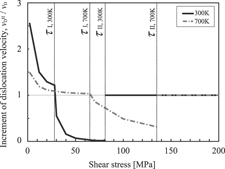Crossref Citations
This article has been cited by the following publications. This list is generated based on data provided by
Crossref.
SEKI, Shoichi
MATSUMOTO, Ryosuke
INOUE, Yoshinori
TAKETOMI, Shinya
and
MIYAZAKI, Noriyuki
2012.
Development of EAM Potential for Fe with Pseudo-Hydrogen Effects and Molecular Dynamics Simulation of Hydrogen Embrittlement.
Journal of the Society of Materials Science, Japan,
Vol. 61,
Issue. 2,
p.
175.
Itakura, M.
Kaburaki, H.
Yamaguchi, M.
and
Okita, T.
2013.
The effect of hydrogen atoms on the screw dislocation mobility in bcc iron: A first-principles study.
Acta Materialia,
Vol. 61,
Issue. 18,
p.
6857.
Aomatsu, Shinnosuke
and
Matsumoto, Ryosuke
2014.
Digital Image Correlation Measurement of Localized Deformation in Carbon Steel in the Presence of Hydrogen.
ISIJ International,
Vol. 54,
Issue. 10,
p.
2411.
Matsumoto, Ryosuke
Seki, Shoichi
Taketomi, Shinya
and
Miyazaki, Noriyuki
2014.
Hydrogen-related phenomena due to decreases in lattice defect energies—Molecular dynamics simulations using the embedded atom method potential with pseudo-hydrogen effects.
Computational Materials Science,
Vol. 92,
Issue. ,
p.
362.
MATSUMOTO, Ryosuke
NISHIGUCHI, Nao
TAKETOMI, Shinya
and
MIYAZAKI, Noriyuki
2014.
First-Principles Calculation of Hydrogen Effects on the Formation and Diffusion of Vacancies in Alpha Iron: Discussion of the Hydrogen-Enhanced Strain-Induced Vacancy Mechanism.
Journal of the Society of Materials Science, Japan,
Vol. 63,
Issue. 2,
p.
182.
Aomatsu, Shinnosuke
and
Matsumoto, Ryosuke
2014.
Effect of Hydrogen on Deformation Behavior of Carbon Steel S25C —Measurement of Time Evolution of Strain Distribution until Crack Initiation Using Digital Image Correlation Method—.
ISIJ International,
Vol. 54,
Issue. 8,
p.
1965.
Matsumoto, Ryosuke
Sera, Masaya
and
Miyazaki, Noriyuki
2014.
Hydrogen concentration estimation in metals at finite temperature using first-principles calculations and vibrational analysis.
Computational Materials Science,
Vol. 91,
Issue. ,
p.
211.
Sasaki, Daisuke
Koyama, Motomichi
and
Noguchi, Hiroshi
2015.
Factors affecting hydrogen-assisted cracking in a commercial tempered martensitic steel: Mn segregation, MnS, and the stress state around abnormal cracks.
Materials Science and Engineering: A,
Vol. 640,
Issue. ,
p.
72.
Koyama, Motomichi
Bashir, Asif
Rohwerder, Michael
Merzlikin, Sergiy V.
Akiyama, Eiji
Tsuzaki, Kaneaki
and
Raabe, Dierk
2015.
Spatially and Kinetically Resolved Mapping of Hydrogen in a Twinning-Induced Plasticity Steel by Use of Scanning Kelvin Probe Force Microscopy.
Journal of The Electrochemical Society,
Vol. 162,
Issue. 12,
p.
C638.
Tomatsu, Kota
Omura, Tomohiko
Nishiyama, Yoshitaka
and
Todaka, Yoshikazu
2016.
Influence of Hydrogen on Local Mechanical Properties of Pure Fe with Different Dislocation Densities Investigated by Electrochemical Nanoindentation.
ISIJ International,
Vol. 56,
Issue. 12,
p.
2298.
Tomatsu, Kota
Miyata, Kaori
and
Omura, Tomohiko
2016.
Electrochemical Nanoindentation Study on Influence of Hydrogen on Local Mechanical Properties of Fcc Metals at Slow Strain Rate.
ISIJ International,
Vol. 56,
Issue. 3,
p.
418.
Rosenberg, G.
and
Sinaiova, I.
2017.
Evaluation of hydrogen induced damage of steels by different test methods.
Materials Science and Engineering: A,
Vol. 682,
Issue. ,
p.
410.
Wakeda, Masato
Tsuru, Tomohito
Kohyama, Masanori
Ozaki, Taisuke
Sawada, Hideaki
Itakura, Mitsuhiro
and
Ogata, Shigenobu
2017.
Chemical misfit origin of solute strengthening in iron alloys.
Acta Materialia,
Vol. 131,
Issue. ,
p.
445.
Taketomi, Shinya
Matsumoto, Ryosuke
and
Hagihara, Seiya
2017.
Molecular Statics Simulation of the Effect of Hydrogen Concentration on {112}<111> Edge Dislocation Mobility in Alpha Iron.
ISIJ International,
Vol. 57,
Issue. 11,
p.
2058.
Taketomi, Shinya
and
Matsumoto, Ryosuke
2018.
Handbook of Mechanics of Materials.
p.
1.
Birenis, Domas
Ogawa, Yuhei
Matsunaga, Hisao
Takakuwa, Osamu
Yamabe, Junichiro
Prytz, Øystein
and
Thøgersen, Annett
2018.
Interpretation of hydrogen-assisted fatigue crack propagation in BCC iron based on dislocation structure evolution around the crack wake.
Acta Materialia,
Vol. 156,
Issue. ,
p.
245.
Ogawa, Yuhei
Birenis, Domas
Matsunaga, Hisao
Takakuwa, Osamu
Yamabe, Junichiro
Prytz, Øystein
and
Thøgersen, Annett
2018.
The role of intergranular fracture on hydrogen-assisted fatigue crack propagation in pure iron at a low stress intensity range.
Materials Science and Engineering: A,
Vol. 733,
Issue. ,
p.
316.
Taketomi, Shinya
and
Matsumoto, Ryosuke
2019.
Handbook of Mechanics of Materials.
p.
283.
Shinko, Tomoki
Hénaff, Gilbert
Halm, Damien
Benoit, Guillaume
Bilotta, Giovambattista
and
Arzaghi, Mandana
2019.
Hydrogen-affected fatigue crack propagation at various loading frequencies and gaseous hydrogen pressures in commercially pure iron.
International Journal of Fatigue,
Vol. 121,
Issue. ,
p.
197.
Shinko, Tomoki
Hénaff, Gilbert
Halm, Damien
Benoit, Guillaume
and
Bahsoun, Hadi
2020.
Characteristic Dependency of Hydrogen-Affected Fatigue Crack Growth and Crack Tip Plasticity on Low Loading Frequency in α-Iron.
Metallurgical and Materials Transactions A,
Vol. 51,
Issue. 8,
p.
4313.


